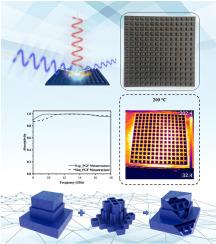3D printed PEEK/CF nanocomposites metamaterial for enhanced resonances toward microwave absorption and compatible camouflage
IF 8.2
2区 材料科学
Q1 MATERIALS SCIENCE, MULTIDISCIPLINARY
引用次数: 0
Abstract
The stealth materials for future weapons and equipment need to operate within the radar working band, be lightweight, easy to process, and compatible with infrared stealth. Integrating all these characteristics poses a significant challenge. This work utilizes poly (ether-ether-ketone)/carbon fibers (PEEK/CF) composite materials and employed reverse-guided manufacturing through simulation design. Incorporating a grid structure within the pyramid metamaterial enables electromagnetic wave reflecting multiple times in various directions. By optimizing the important interaction between dielectric properties of the materials structures,the Pyramid Grid Filled Metamaterial enables broadband electromagnetic wave absorption (<-10 dB, 8–18 GHz), weak angular dependence (5- 45o incidence), polarization insensitivity, radar cross section (RCS) reduction (reduction over 10 dB between θ = −60° and 60°), and infrared camouflage performance. The PGF metamaterial of 180◊180 mm2, weighs only 103.1 g at a thickness of 9 mm. This work paves a way for the design the radar infrared compatible composite metamaterials.

三维打印 PEEK/CF 纳米复合材料超材料,用于增强微波吸收共振和兼容伪装
未来武器装备的隐形材料需要在雷达工作波段内工作,重量轻,易于加工,并与红外隐形兼容。整合所有这些特性是一项重大挑战。这项研究利用聚醚醚酮/碳纤维(PEEK/CF)复合材料,通过模拟设计采用反向引导制造。在金字塔超材料中加入网格结构,可实现电磁波在不同方向的多次反射。通过优化材料结构介电特性之间的重要相互作用,金字塔网格填充超材料实现了宽带电磁波吸收(-10 dB,8-18 GHz)、弱角度依赖性(5-45°入射角)、极化不敏感性、雷达截面(RCS)减小(θ = -60° 和 60° 之间减小超过 10 dB)和红外伪装性能。PGF 超材料的面积为 180◊180 平方毫米,厚度为 9 毫米,重量仅为 103.1 克。这项工作为设计雷达红外兼容复合超材料铺平了道路。
本文章由计算机程序翻译,如有差异,请以英文原文为准。
求助全文
约1分钟内获得全文
求助全文
来源期刊

Materials Today Nano
Multiple-
CiteScore
11.30
自引率
3.90%
发文量
130
审稿时长
31 days
期刊介绍:
Materials Today Nano is a multidisciplinary journal dedicated to nanoscience and nanotechnology. The journal aims to showcase the latest advances in nanoscience and provide a platform for discussing new concepts and applications. With rigorous peer review, rapid decisions, and high visibility, Materials Today Nano offers authors the opportunity to publish comprehensive articles, short communications, and reviews on a wide range of topics in nanoscience. The editors welcome comprehensive articles, short communications and reviews on topics including but not limited to:
Nanoscale synthesis and assembly
Nanoscale characterization
Nanoscale fabrication
Nanoelectronics and molecular electronics
Nanomedicine
Nanomechanics
Nanosensors
Nanophotonics
Nanocomposites
 求助内容:
求助内容: 应助结果提醒方式:
应助结果提醒方式:


